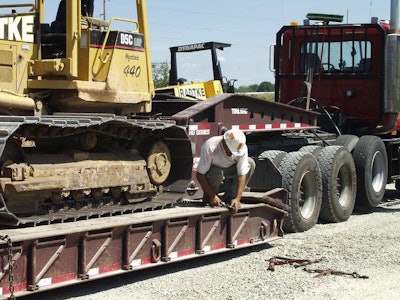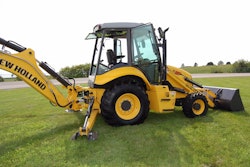
The Moving Ahead for Progress in the 21st Century Act (MAP-21) was passed by Congress and signed by President Obama in the summer of 2012. One of the act’s provisions required a comprehensive truck size and weight limits study to be completed by the United States Department of Transportation (USDOT). A date to report back to Congress was initially set for November of 2014.
A report of the study and any regulatory recommendations that it may carry have been eagerly anticipated by both the heavy haul industry and safety organizations. The study was released last month and Congress received a detailed report. As the name implied, it would be comprehensive—and indeed it was. The report is broken into two volumes covering six topics plus additional supplemental material, totaling some 1,230 pages.
The bottom line? The issue is currently too complex to fully understand and advise of any changes to the federal size and weight regulations in 23 CFR Part 658. The USDOT offered the following in its supplemental material:
“…efforts to assess the full effects of the size and weight of various trucks are hindered by many of the same significant data limitations identified in previous studies. The Department finds that the current data limitations are so profound that no changes in the relevant laws and regulations should be considered until these data limitations are overcome.”
The heavy haul industry was hoping for some movement on the total gross weight limitations, and other transportation interests were hoping for longer trailer combination lengths.
What was studied?
The study focused on five technical areas, including an analysis of: modal shifts, highway safety, compliance, bridge conditions, and pavement conditions. These technical areas were analyzed using eight different configurations:
Single Trailer Combinations (all tractors used had three axles):
- 5-axle combination with a 53-foot semitrailer and a gross weight of 80,000 pounds (control)
- 5-axle combination with a 53-foot semitrailer and a gross weight of 88,000 pounds
- 6-axle combination with a 53-foot semitrailer and a gross weight of 91,000 pounds
- 6-axle combination with a 53-foot semitrailer and a gross weight of 97,000 pounds
Multiple Trailer Combinations
- Tractor plus two 28- or 28½-foot trailers with a gross vehicle weight of 71,700 pounds (control)
- Tractor plus two 33-foot trailers with a gross vehicle weight of 80,000 pounds
- Tractor plus three 28- or 28½-foot trailers with a gross vehicle weight of 105,000 pounds
- Tractor plus three 28- or 28½-foot trailers with a gross vehicle weight of 129,000 pounds
Even though the study included multiple trailer configurations up to 129,000 pounds, we’ll focus on the results using a single 53-foot trailer with gross weights up to 97,000 pounds.
One of the major inhibiting factors to determine the relationship of gross vehicle weight to crashes is that most states do not include the vehicle’s weight data on crash reports. In Michigan, Washington, and Idaho, where six-axle alternative truck configurations are allowed and data was available, the study found that “the crash involvement rate for the six-axle alternative truck configurations is consistently higher than the rate for the five-axle control truck.”
The study pointed out, though, that to determine the cause of the accidents additional study would be necessary. Perhaps more meaningful to the discussion is the analysis of vehicle stability and control. The tests examined “low speed off-tracking, high-speed off-tracking, straight line stopping distance, brake in a curve, and avoidance maneuver.” Field testing data related to stopping performance was also used from the Federal Motor Carrier Safety Administration (FMCSA).
A case for change?
The findings of the maneuver simulations indicated that all the heavier single trailer configurations “did not differ appreciably from those of the five-axle control vehicle” (at 80,000 pounds). The results included the following statements:
- None of the maneuvers identified a condition where the stability of a single-semitrailer combination was severely impaired by the addition of payload weight or a third trailer axle.
- Adding weight to the payload increased the stopping distance on dry road by less than 10 percent; in the proportions selected for the study, the additional brakes on the third trailer axle compensated for the additional payload in Scenario 2 (6-axle combination with 53 foot semitrailer and a gross weight of 91,000 pounds).
- Simulating a complete right-side brake failure on both drive axles increased the stopping distance, and the effect of that failure on the scenarios was similar to its effect on the control vehicle.
- The differences between the results for the four single-trailer combinations are not significant. Off-tracking is minimal for all scenarios.
The pavement analysis provided interesting results in that the pavement life cycle cost (LCC) for the 6-axle combinations with 53-foot semitrailers and gross weights of 91,000 and 97,000 pounds actually would be expected to decrease. This makes sense because more axles are sharing the burden.
Throughout the report there were other off-setting points. The off-sets were particularly evident in “Safety Inspection and Violations Results” (higher violation, citation, and OOS violation rates) and the analysis of “Bridge Structure” (increased cost of maintenance and postings).
While the USDOT was unable to make concrete suggestions to Congress, individual members, committees, and chambers may be persuaded to move forward. Both the House of Representatives and the Senate Appropriations Committees included in their respective versions of the Fiscal Year 2016 Transportation, Housing, and Urban Development bills a provision to allow tandem 33-foot trailers, which was part of the study. The full House passed the bill with the provision included.
In addition, the Coalition for Transportation Productivity (CTP) sent a letter and an informational sheet on July 6, 2015, to Congress that urged members to review data from the Comprehensive Truck Size & Weight Limits Study, and to take action to reform interstate vehicle weight limits for six-axle trucks.
There have been no updates to the gross vehicle weights allowed on the Interstates and Designated Highway System for many years. Canada, Europe, and Australia all allow higher gross weights than the United States without using a permit system. Whether or not the United States will follow suit could be a matter of debate, but certainly there appears to be reason to have that conversation if not an outright case for change.












